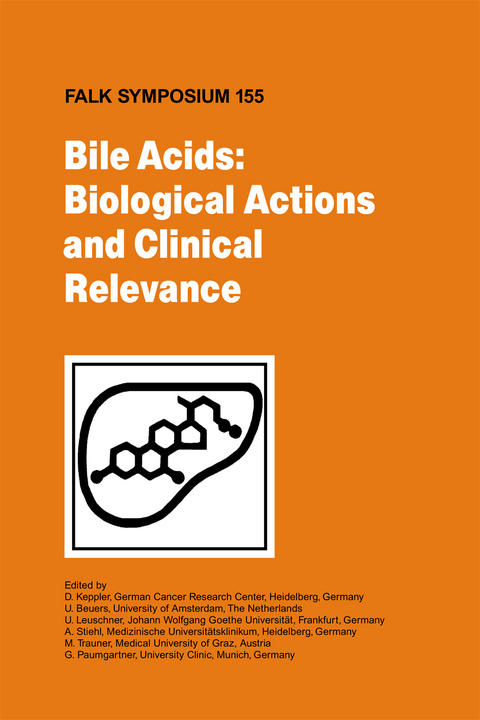
Bile Acids: Biological Actions and Clinical Relevance
Springer-Verlag New York Inc.
978-1-4020-6251-3 (ISBN)
This book reflects the recent progress in bile acid metabolism and transport, nuclear receptor regulation and signaling by bile acids, as well as mechanisms of bile acid-induced cellular injury. Coverage examines bile acids as therapeutic agents, particularly for the treatment of cholestatic liver diseases. This volume in the Falk Symposium series brings together basic science and clinical hepatology in the field of bile acids.
Metabolism of bile acids.- Analysis of mice deficient in the bile acid biosynthetic enzyme 3?-hydroxy-?5-C27-steroid oxidoreductase (HSD3B7).- Role of oxysterols and cholestenoic acids in a crosstalk between the brain and the liver.- Activation of a G-protein coupled receptor by conjugated bile acids in primary hepatocytes and liver: effects on glucose metabolism.- Discovery of a novel oxysterol, 5-cholesten-3?, 25-diol 3-sulphate, in nuclei and mitochondria following over-expression of the gene encoding StarD1.- Hepatobiliary transport of bile acids.- Role of Ntcp phosphorylation in cAMP-mediated stimulation of hepatic bile acid uptake.- The concept of basolateral efflux pumps of the hepatocyte.- Insights into the regulation of expression of human OST?-OST?.- Regulation of hepatobiliary transport proteins in chronic cholestasis.- Assessment of inhibitory effect of many therapeutically important drugs on bile acid transport by NTCP, BSEP and other transporters.- Extrahepatocytic transport and actions of bile acids.- Extrahepatocytic transport of bile acids: the role of the cholangiocyte.- Molecular mechanisms of intestinal basolateral bile acid transport.- Regulation of intestinal bile acid transport in health and disease.- Evidence for a role of the FXR-driven intestinal regulatory factor FGF-19 upon cholestyramine and chenodeoxycholic acid treatment and during the diurnal regulation of bile acid synthesis in humans.- Nuclear receptor regulation.- Bile acid-like hormones function as ligands for the nematode orphan nuclear receptor DAF-12 and govern dauer formation, reproduction and lifespan.- Regulation of CYP7A1 by nuclear receptor signalling in human liver cells.- Regulation of hepatic and intestinal bile acid transport by FXR-controlled pathways.- Regulation ofbile acid homeostasis by the nuclear bile acid receptor FXR and fibroblast growth factor 15.- Bile salts activate endothelial no synthase in sinusoidal endothelial cells of the liver via the G-protein coupled receptor TGR5.- Bile acids, cellular injury, and disease mechanisms.- Bile salt-induced CD95 activation.- Role of Fas and caspase 8 in glycochenodeoxycholic acid-induced hepatocellular apoptosis in human liver cell lines.- Disulphated progesterone metabolites in urine relate to pruritus in intrahepatic cholestasis of pregnancy treated with ursodeoxycholic acid.- Adolf windaus prize lecture: primary biliary cirrhosis: from ursodeoxycholic acid towards targeting strategies for therapies.- Bile acids, cellular injury, and hepatic fibrosis.- Bile acids and liver fibrosis —Causative agent and therapeutic tool.- Mechanisms of bile acid-induced cell death in vivo and in vitro.- Bile acids enhance cellular motility of the hepatic myofibroblast-like cell through the regulation of p38/JNK signalling.- Bile acids as therapeutic agents: mechanisms and actions.- Side-chain-shortened bile acids for the treatment of cholestasis: lessons from nor-ursodeoxycholic acid.- Ursodeoxycholic acid-disulphate (SUDCA) — a potent chemopreventive agent against colon cancer.- Prevention of cholesterol gallstones by the potent cholesterol absorption inhibitor ezetimibe in gallstone-susceptible C57L/J mice.- Tauroursodeoxycholic acid antagonizes taurolithocholic acid-induced cholestasis via a cooperative protein kinase C-and protein kinase A-dependent signalling pathway in the perfused rat liver.- Bile acids in the treatment of cholestatic liver disease.- Ursodeoxycholic acid for the treatment of primary sclerosing cholangitis.- Role of polymorphisms in genes involved in bile aciddetoxification pathways in primary sclerosing cholangitis.- High-dose ursodeoxycholic acid in the treatment of primary sclerosing cholangitis.- Primary sclerosing cholangitis: bile duct and colonie carcinomas after long-term ursodeoxycholic acid.
| Erscheint lt. Verlag | 22.6.2007 |
|---|---|
| Reihe/Serie | Falk Symposium ; 155 |
| Zusatzinfo | XVII, 270 p. |
| Verlagsort | New York, NY |
| Sprache | englisch |
| Maße | 155 x 235 mm |
| Themenwelt | Medizinische Fachgebiete ► Chirurgie ► Viszeralchirurgie |
| Medizinische Fachgebiete ► Innere Medizin ► Gastroenterologie | |
| Naturwissenschaften ► Biologie ► Zoologie | |
| ISBN-10 | 1-4020-6251-6 / 1402062516 |
| ISBN-13 | 978-1-4020-6251-3 / 9781402062513 |
| Zustand | Neuware |
| Haben Sie eine Frage zum Produkt? |
aus dem Bereich


